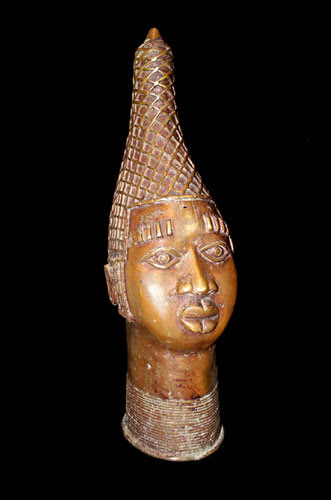Benin Style Bronze Head of an Iyoba (Queen Mother), 20th Century CE
bronze
21
LSO.576 (GD.103)
The vast majority of Benin’s artworks are designed to honour the achievements and/or memory of the Obas, the divine rulers of the Benin polities. Until the late 19th century, the...
The vast majority of Benin’s artworks are designed to honour the achievements and/or memory of the Obas, the divine rulers of the Benin polities. Until the late 19th century, the Benin centres were a ruling power in Nigeria, dominating trade routes and amassing enormous wealth as the military and economic leaders of their ancient empire. This changed with the appearance of the British forces, which coveted the wealth of the royal palaces and found a series of excuses to mount a punitive expedition against the Oba’s forces in 1897. It was only at this point, the moment of its’ destruction, that the true achievements of the Benin polities became apparent to western scholars. The palaces were a sprawling series of compounds, comprising accommodation, workshops and public buildings. As it grew, the buildings pertaining to previous Obas were either partially refurbished or left in favour of newer constructions; this led to a long history of royal rule written in sculptural works that rank among the finest that African cultures have ever produced. The technology of bronze and copper smelting, ironworking and sculpting in a range of materials that particularly included ivory was extremely refined and effective; indeed, smelting, forging and cire perdue (lost wax) metalworking methods exceeded any seen in Europe until the 19th century. Brass or bronze Oba heads were made to honour the memory of a deceased king. Typically, the son of the dead king – the new Oba – would pay tribute to his father by erecting an altar in his memory. These altars, low platforms of mud that were arrayed around the perimeter of the royal courtyards, were decorated with various artefacts alluding to the Oba’s achievements in life. Further decorations included spears, statues, cast brass altars depicting the Oba and his followers, brass bells to awaken the spirits, rattle-staffs (ukhurhe) and magical objects that included Neolithic celts (known as “thunder stones”). In traditional Benin society, the queen mother (Iyoba) is also commemorated in this way, following a edict laid down by Oba Esigie in the early 16th century. The first wife of the Oba to give birth to a live male son receives this title, for in a divine kingship system she is as important as Mary is to Christians, or Amina to Muslims. In social terms, her duties usually include the running of an administrative area for her son. She was thus entitled to wear the exclusive coral-bead crown as shown here. In death, she is honoured in a manner similar to that of her husband/son, with a low mud platform bearing religious and magical paraphernalia, including heads such as the present example. Iyoba heads can be differentiated from those of Obas by the forward-pointing “chickens beak” hairstyle which forms a shape known as the “ede Iyoba”. There are two major types – the thin-walled and delicate type that is usually deemed to be earlier (c. 16th century), and a heavier type with a mouth-high cylindrical beaded collar that is associated with Oba head grades 4-5 of Dark’s monumental typology. This piece is modelled in the former style, with aquiline elegance. It has the tall lattice-work hairdo, with dangling strands that indicate the coral bead crown that only Iyobas were allowed to wear. The face is strongly modelled, with full lips, well-defined eyes and a broad, firm nose. The forehead is scarred with 8 marks indicating status, and there is an aperture for a central diadem, now lost. The head sits on a series of around twenty narrow neck rings that come less than halfway up the neck. Although it is a relatively recent reinterpretation of an ancient tradition, it is nonetheless a well-executed and impactual piece of African art that would be an entertaining and unusual conversation piece for home or office alike.



